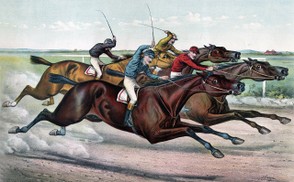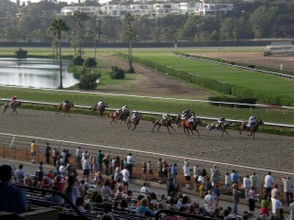The most notable thing about American Pharoah's 2015 Belmont Stakes run was, perhaps, the fact that he ran the last quarter mile of it faster than Secretariat. But, secondly, the bay colt won the Triple Crown of American horse racing in breezy style at a point in time when most fans and many horsemen claimed winning the Triple was no longer possible.

American Pharoah Comparisons to Other Triple Crown Winners of Horse Racing
by BAHelberg
American Pharoah's victories in the 2015 American Triple Crown races earned him the 12th ever Crown in USA horse racing history. How does he compare to other Triple winners?
Better Than Secretariat
American Pharoah's Belmont
In a time when few believed an American Triple Crown of horse racing ever could be won again, appropriately named (but misspelled in a contest to give him a name) American Pharoah came along this season to put out those flames of doubt.
In fact, he breezed through the muddy, rainy Preakness Stakes (leg two) and rushed to a record final quarter mile time while wiring the Belmont Stakes (third leg) after scoring a huge rally in the crowded Kentucky Derby (first leg.) And those facts mean American Pharoah was tested in every way a racehorse can be tested in the American classics.
American Pharoah, in the end, bested Secretariat's 25.0 flat in the final quarter of the 1-1/2 miles Belmont. Secretariat won the Belmont going away by an incredible and never seen again 31 lengths, running his final quarter of the Triple Crown series like the icon he became.
But American Pharoah concluded his Triple triumph with a final quarter time of 24.32. His total time of 2:26.65 for the 1-1/2 miles Belmont Stakes is second to Secretariat's still standing, all-time speed record (2:24.0) for the race.
Hall of Fame trainer Bob Baffert commented after the Belmont that American Pharoah does everything easily. No one had a dispute with that statement.
American Triple Crown Horse Races
Where are the American Triple Crown Races Run?
Sir Barton's Quick TurnAround
Triple Crown Races Run Differently
Because Sir Barton was the first Triple Crown winner in American horse racing history, his victory in the three classics hadn't yet been referred to as the Triple.
It was a day of slashing rain when Sir Barton, theretofore winless, entered the Kentucky Derby gate. Neither favored, nor thought of as a threat, in the Derby, Sir Barton led the entire distance of 1-1/4 miles on May 10, 1919.
Less than a week later, the Derby victor went to the (then) 1-1/8 miles Preakness Stakes and triumphed again. And on June 11, Sir Barton romped through the 1-3/8 miles Belmont Stakes under jockey Johnny Loftus, drawing off by five lengths.
Sir Barton achieved a new American record at the time for the Belmont at that distance, covering the race in 2:17-2/5.
How Gallant Fox Did It
Preakness Stakes Run First in Triple Triumph
In 1930, Gallant Fox became the first horse since Sir Barton to win all three classics run exclusively for three-year-old Thoroughbreds -- the Kentucky Derby, the Preakness Stakes, and the Belmont Stakes.
However, Gallant Fox had a different classics schedule in which to perform his task. The Preakness Stakes was the first leg of the series. Run on May 9, the Preakness also featured for the first time in American racing, "the machine" -- an automatic metal starting gate. Before that time, races were started by flag, or gunshot, with the participating horses more, or less, lined up at a drawn starting point.
Eight days after his Preakness Stakes victory at 3/4 of a length, Gallant Fox entered the Kentucky Derby, clearing the field by two lengths.
Even though he'd won two of the three classics entering the Belmont on June 7, Sir Barton hadn't earned the favorite's role. Whichone was favored to take the final leg of the Triple journey. But The Sir had other ideas. By a comfortable three lengths, he swept his opponents and took his place in history as just the second Thoroughbred to win all three classics.
Of ten total starts in 1930, Gallant Fox won nine, losing only in the Travers Stakes, where he finished second. His total earnings for that year were $308,275.
Whirlaway Went to Post 60 Times
Comparing Racing Returns of Triple Crown Winners
American Triple Crown horse racing champions have returned to racing after their run in the classics competition on very different time frames.
War Admiral, son of the great Man o' War, was rested for a record 143 days due to a right foreleg injury before he raced again (following his 1937 Triple triumph) and won the Pimlico Special. War Admiral stumbled coming out of the Preakness gate and suffered additional injuries in the Belmont, yet remained on the 1937 racing schedule, going eight for eight on the year.
Omaha, 1935's son of Gallant Fox, had the shortest return to racing of all the Triple Crown champs. He entered the Brooklyn Handicap just 14 days after completing his Triple sweep and lost to future Hall of Famer Discovery at Aqueduct Racetrack.
The Champions of the American Triple Crown:
1919 -- Sir Barton
1930 -- Gallant Fox
1935 -- Omaha
1941 -- Whirlaway
1943 -- Count Fleet
1946 -- Assault
1948 -- Citation
1973 -- Secretariat
1977 -- Seattle Slew
1978 -- Affirmed
2015 -- American Pharoah
The standardized distances of the Triple Crown races are: Kentucky Derby, 1-1/4 miles; Preakness Stakes, 1-3/16 miles; Belmont Stakes, 1-1/2 miles.
Affirmed needed a seven-length rally in the stretch in the Jim Dandy to win that race, his first 59 days after the Belmont.
Sir Barton went back to his losing ways (to Purchase) in the 1919 Dwyer Stakes 29 days after his Triple championship was in the books.
Seattle Slew, who had suffered illnesses and was thought by some to be unfit, lost to J.O. Tobin in the 1977 Swaps Stakes at Hollywood Park 23 days out from his convincing Belmont victory.
Count Fleet didn't return to racing after winning the Triple Crown.
Following his Triple Crown championship, Secretariat took a brief respite, then won four of six races, including two on grass, that concluded his three-year-old season and his career. Those wins included the first ever Marlboro Cup Handicap and the Canadian International Championship Stakes in Ontario, Canada.
Whirlaway was one of the busiest racehorses in history, going to post 60 times over four years' time. After his 1941 Triple victory, he quickly gobbled up the Dwyer, the Travers, the American Derby, and the Lawrence Realization, plus placed in the Arlington Classic and Jockey Club Gold Cup. The word "rest" didn't exist in his schedule.
Unstoppable through 16 consecutive races (1948 and 1950), Citation was also a prolific racer. In four years, skipping 1949 because of nagging injuries, he posted 45 times. Citation won the Jersey Derby in between the Preakness and the Belmont. In 1948 alone, Cy raced 20 times, winning 19.
Assault was a club-footed speedster injured when he stepped on a surveyor's field stake. Two weeks after his Triple run, he, like several other Triplers, entered the Dwyer Stakes and won. His career spanned six seasons and 42 posts.
Gallant Fox, the only Triple Crown winner to sire a Triple Crown winner (Omaha), returned to the track three weeks after the Belmont and scored in the Dwyer.
What's Next for American Pharoah?
Baffert Likes His Colt's Demeanor
Baffert has won 12 Triple Crown races in total -- four Kentucky Derbys, six Preakness Stakes, and two Belmont Stakes. Only D.Wayne Lucas has won more -- 13.
What Baffert sees next for American Pharoah are two prep races before the Breeders' Cup Championships at the end of October. The first target for his bay champion would be the August 2 million dollar gem, the Haskell Invitational Stakes (G1) at Monmouth Park in New Jersey.
That would give American Pharoah a comparison eight weeks off from competitive racing, a long stretch versus the time away posted by most of the previous Triple Crown champions.
But Baffert and the colt's jockey, three-time Kentucky Derby winner Victor Espinoza, agree that American Pharoah is in superb condition and races as easily as any Thoroughbred they've coached.
American Pharoah's owner, Ahmed Zayat of Zayat Stables LLC, has already sold the colt's breeding rights and agreed to retire Amercian Pharoah at the end of his three-year-old campaign. He remains eager, however, he claimed, to bring the colt to his adopted hometown track in New Jersey to share the champ with the "home crowd".
In eight career starts, American Pharoah has seven victories, losing only in his inaugural race as a two-year-old in 2014, when he captured Two-Year-Old Male Champion honors. His current earnings top $3 Million.
Credit Note
The thumbnail image for this post is from the Book Cover of the author's personal copy of "The Black Stallion's Courage", by Walter Farley, 1956, Random House, New York, NY.
You might also like
Back to the ThamesAfter two years absence the Oxford-Cambridge boat race returned to its tradit...
Space Marathons, the First and the Most Famous of Space SportsSpace marathons are repeat events with Major Tim Peake’s space-run of the Lon...








 Shoemaker's 23 Kentucky Derbieson 09/04/2018
Shoemaker's 23 Kentucky Derbieson 09/04/2018
 California Chrome Becomes New Thoroughbred Money Leaderon 04/08/2016
California Chrome Becomes New Thoroughbred Money Leaderon 04/08/2016
 Jockey Ramon Dominguez Continues Skull Fracture Rehabon 02/24/2013
Jockey Ramon Dominguez Continues Skull Fracture Rehabon 02/24/2013
 Retired Jockey Gary Stevens Comes Back at Santa Anitaon 02/21/2013
Retired Jockey Gary Stevens Comes Back at Santa Anitaon 02/21/2013



Are You A Fan of Horse Racing Fiction?